The Revolutionary Impact of ICT on the Global Tourism Sector
VerifiedAdded on 2020/11/23
|15
|4359
|321
Report
AI Summary
This report comprehensively discusses the transformative impact of technological developments, particularly Information and Communication Technologies (ICT), on the tourism industry. It begins by outlining key theories of technological innovation, including Schumpeter's theory and the diffusion theory of innovation, providing a foundation for understanding the evolution of the industry. The report then delves into the specific ways in which technological advancements have reshaped the tourism landscape, from marketing and operations to consumer interactions. It explores key concepts such as value chain analysis and the application of Porter's five forces to assess competitiveness within the industry. Furthermore, it highlights the emergence of smart tourism and e-tourism, emphasizing the role of social media and online platforms in connecting businesses with consumers. The report concludes with an analysis of the changing nature of the tourism industry structure, emphasizing the importance of adapting to technological advancements to remain competitive in the global market. This report underscores the critical role of ICT in driving innovation, enhancing customer experiences, and shaping the future of the tourism sector.
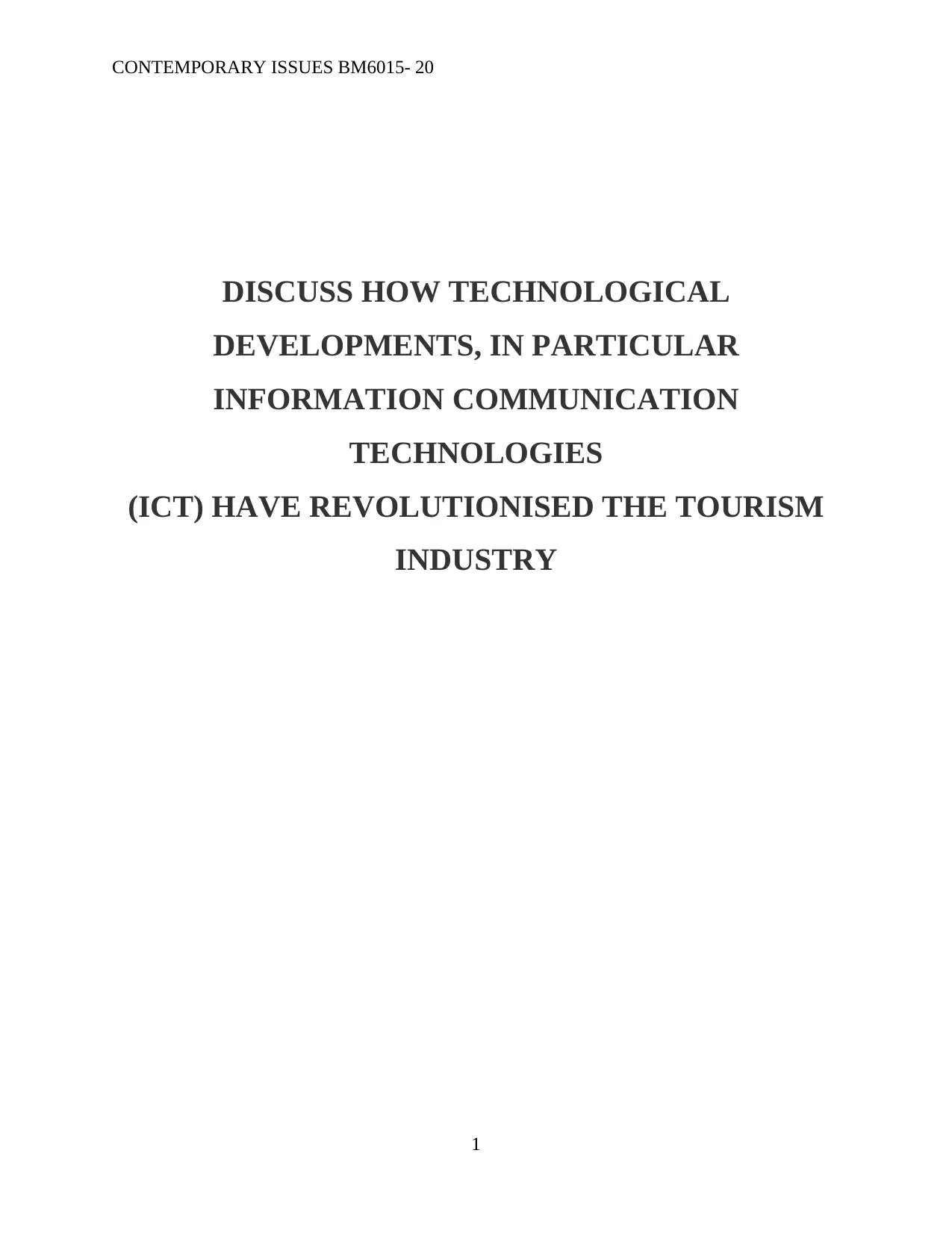
CONTEMPORARY ISSUES BM6015- 20
DISCUSS HOW TECHNOLOGICAL
DEVELOPMENTS, IN PARTICULAR
INFORMATION COMMUNICATION
TECHNOLOGIES
(ICT) HAVE REVOLUTIONISED THE TOURISM
INDUSTRY
1
DISCUSS HOW TECHNOLOGICAL
DEVELOPMENTS, IN PARTICULAR
INFORMATION COMMUNICATION
TECHNOLOGIES
(ICT) HAVE REVOLUTIONISED THE TOURISM
INDUSTRY
1
Paraphrase This Document
Need a fresh take? Get an instant paraphrase of this document with our AI Paraphraser
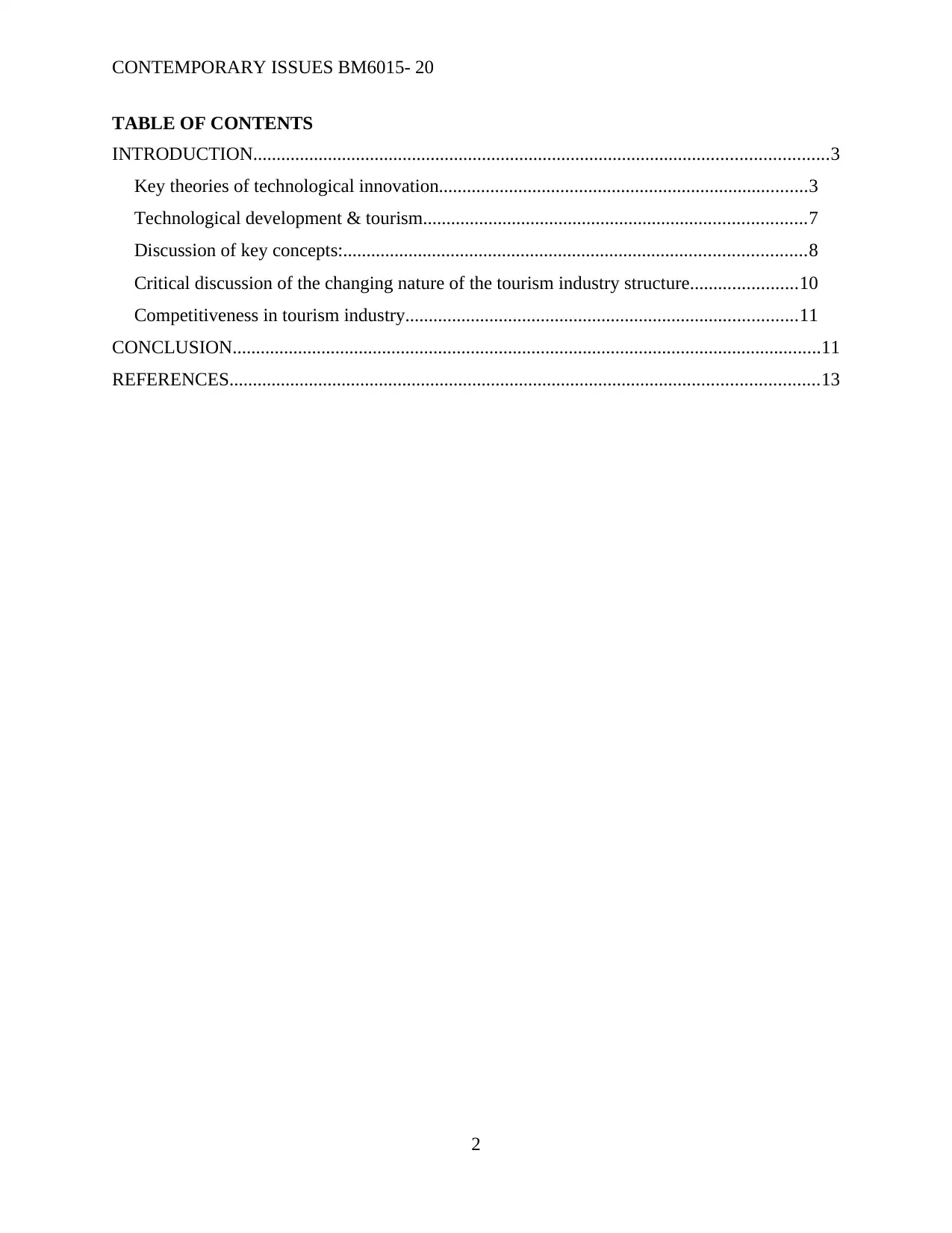
CONTEMPORARY ISSUES BM6015- 20
TABLE OF CONTENTS
INTRODUCTION...........................................................................................................................3
Key theories of technological innovation...............................................................................3
Technological development & tourism..................................................................................7
Discussion of key concepts:...................................................................................................8
Critical discussion of the changing nature of the tourism industry structure.......................10
Competitiveness in tourism industry....................................................................................11
CONCLUSION..............................................................................................................................11
REFERENCES..............................................................................................................................13
2
TABLE OF CONTENTS
INTRODUCTION...........................................................................................................................3
Key theories of technological innovation...............................................................................3
Technological development & tourism..................................................................................7
Discussion of key concepts:...................................................................................................8
Critical discussion of the changing nature of the tourism industry structure.......................10
Competitiveness in tourism industry....................................................................................11
CONCLUSION..............................................................................................................................11
REFERENCES..............................................................................................................................13
2
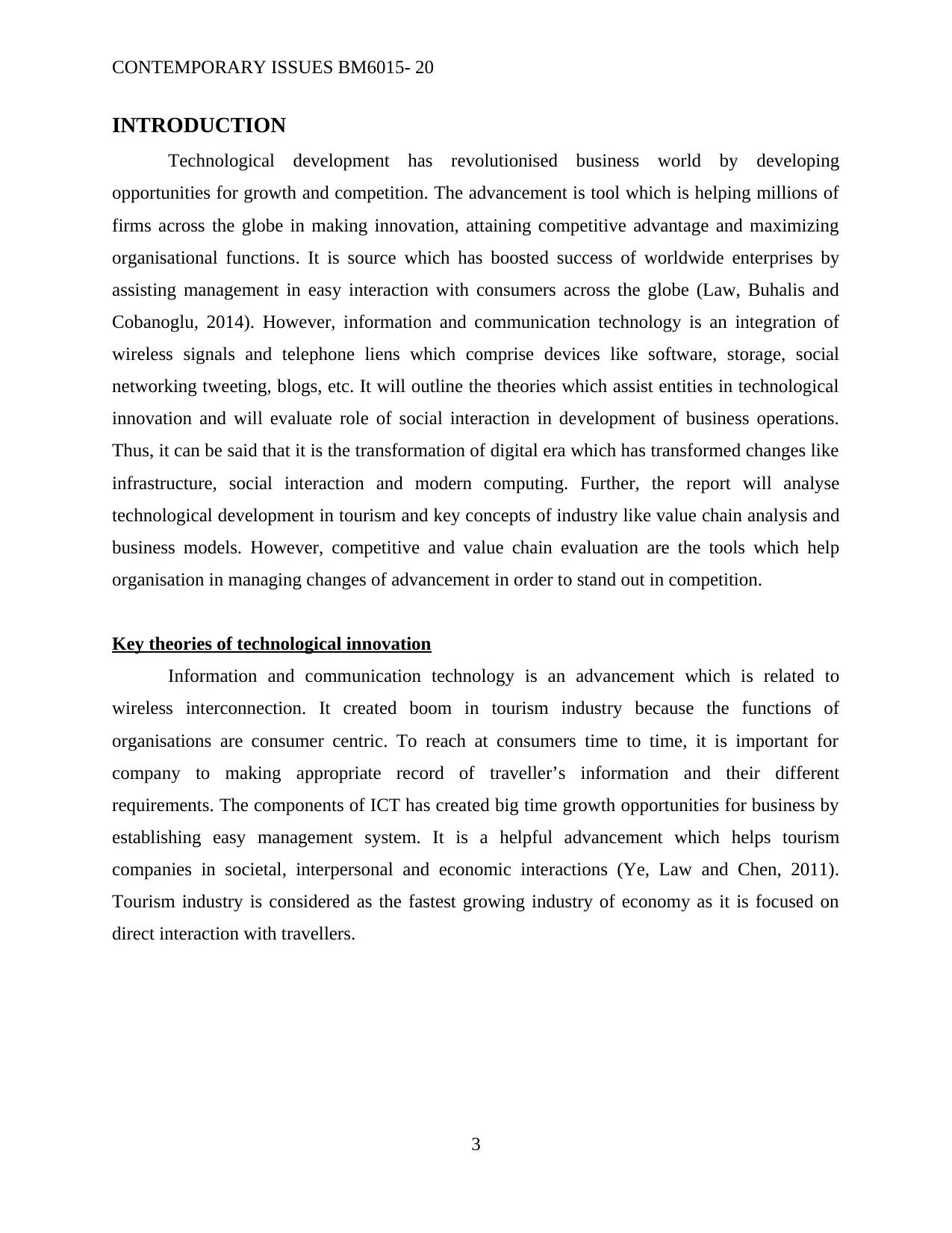
CONTEMPORARY ISSUES BM6015- 20
INTRODUCTION
Technological development has revolutionised business world by developing
opportunities for growth and competition. The advancement is tool which is helping millions of
firms across the globe in making innovation, attaining competitive advantage and maximizing
organisational functions. It is source which has boosted success of worldwide enterprises by
assisting management in easy interaction with consumers across the globe (Law, Buhalis and
Cobanoglu, 2014). However, information and communication technology is an integration of
wireless signals and telephone liens which comprise devices like software, storage, social
networking tweeting, blogs, etc. It will outline the theories which assist entities in technological
innovation and will evaluate role of social interaction in development of business operations.
Thus, it can be said that it is the transformation of digital era which has transformed changes like
infrastructure, social interaction and modern computing. Further, the report will analyse
technological development in tourism and key concepts of industry like value chain analysis and
business models. However, competitive and value chain evaluation are the tools which help
organisation in managing changes of advancement in order to stand out in competition.
Key theories of technological innovation
Information and communication technology is an advancement which is related to
wireless interconnection. It created boom in tourism industry because the functions of
organisations are consumer centric. To reach at consumers time to time, it is important for
company to making appropriate record of traveller’s information and their different
requirements. The components of ICT has created big time growth opportunities for business by
establishing easy management system. It is a helpful advancement which helps tourism
companies in societal, interpersonal and economic interactions (Ye, Law and Chen, 2011).
Tourism industry is considered as the fastest growing industry of economy as it is focused on
direct interaction with travellers.
3
INTRODUCTION
Technological development has revolutionised business world by developing
opportunities for growth and competition. The advancement is tool which is helping millions of
firms across the globe in making innovation, attaining competitive advantage and maximizing
organisational functions. It is source which has boosted success of worldwide enterprises by
assisting management in easy interaction with consumers across the globe (Law, Buhalis and
Cobanoglu, 2014). However, information and communication technology is an integration of
wireless signals and telephone liens which comprise devices like software, storage, social
networking tweeting, blogs, etc. It will outline the theories which assist entities in technological
innovation and will evaluate role of social interaction in development of business operations.
Thus, it can be said that it is the transformation of digital era which has transformed changes like
infrastructure, social interaction and modern computing. Further, the report will analyse
technological development in tourism and key concepts of industry like value chain analysis and
business models. However, competitive and value chain evaluation are the tools which help
organisation in managing changes of advancement in order to stand out in competition.
Key theories of technological innovation
Information and communication technology is an advancement which is related to
wireless interconnection. It created boom in tourism industry because the functions of
organisations are consumer centric. To reach at consumers time to time, it is important for
company to making appropriate record of traveller’s information and their different
requirements. The components of ICT has created big time growth opportunities for business by
establishing easy management system. It is a helpful advancement which helps tourism
companies in societal, interpersonal and economic interactions (Ye, Law and Chen, 2011).
Tourism industry is considered as the fastest growing industry of economy as it is focused on
direct interaction with travellers.
3
⊘ This is a preview!⊘
Do you want full access?
Subscribe today to unlock all pages.

Trusted by 1+ million students worldwide
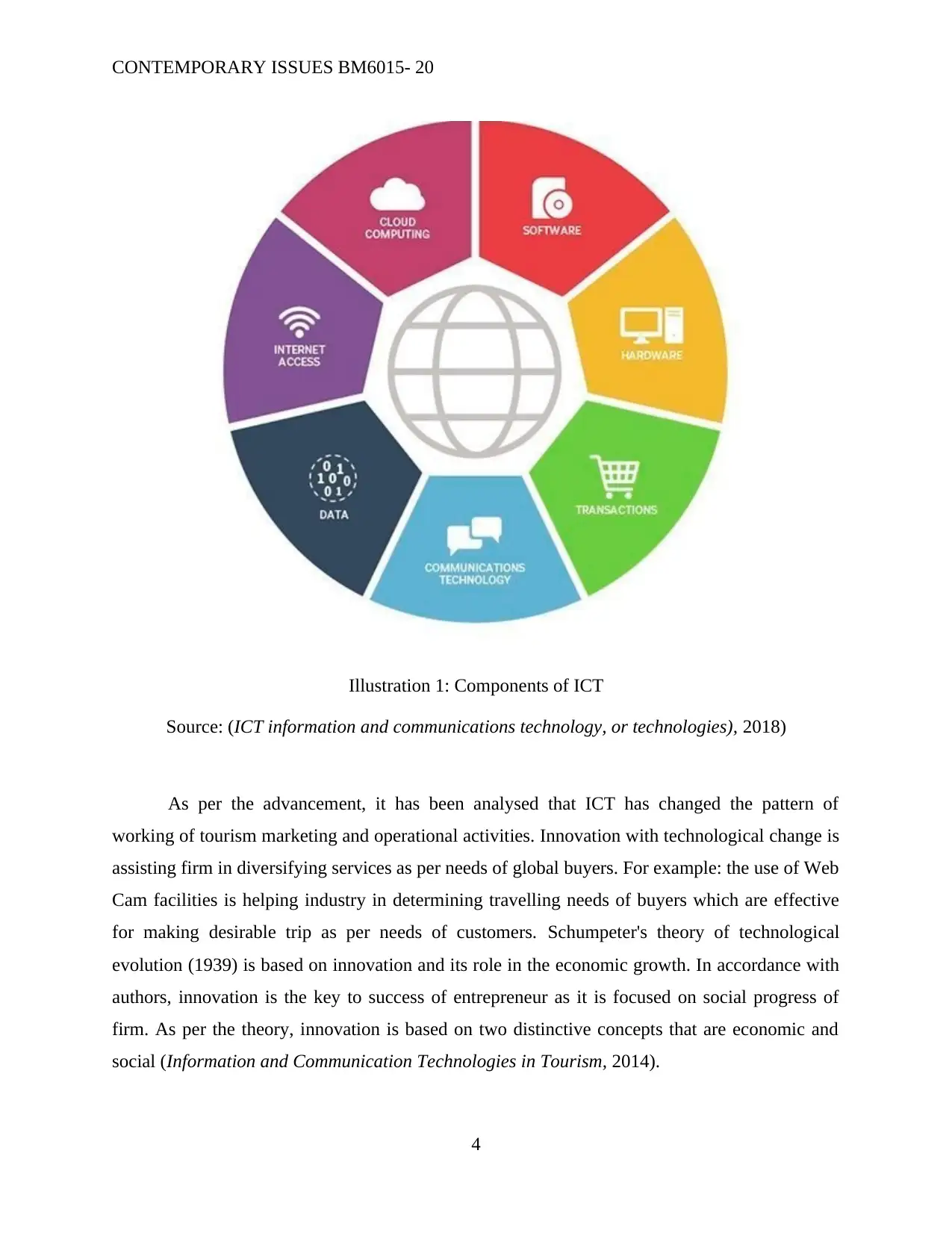
CONTEMPORARY ISSUES BM6015- 20
As per the advancement, it has been analysed that ICT has changed the pattern of
working of tourism marketing and operational activities. Innovation with technological change is
assisting firm in diversifying services as per needs of global buyers. For example: the use of Web
Cam facilities is helping industry in determining travelling needs of buyers which are effective
for making desirable trip as per needs of customers. Schumpeter's theory of technological
evolution (1939) is based on innovation and its role in the economic growth. In accordance with
authors, innovation is the key to success of entrepreneur as it is focused on social progress of
firm. As per the theory, innovation is based on two distinctive concepts that are economic and
social (Information and Communication Technologies in Tourism, 2014).
4
Illustration 1: Components of ICT
Source: (ICT information and communications technology, or technologies), 2018)
As per the advancement, it has been analysed that ICT has changed the pattern of
working of tourism marketing and operational activities. Innovation with technological change is
assisting firm in diversifying services as per needs of global buyers. For example: the use of Web
Cam facilities is helping industry in determining travelling needs of buyers which are effective
for making desirable trip as per needs of customers. Schumpeter's theory of technological
evolution (1939) is based on innovation and its role in the economic growth. In accordance with
authors, innovation is the key to success of entrepreneur as it is focused on social progress of
firm. As per the theory, innovation is based on two distinctive concepts that are economic and
social (Information and Communication Technologies in Tourism, 2014).
4
Illustration 1: Components of ICT
Source: (ICT information and communications technology, or technologies), 2018)
Paraphrase This Document
Need a fresh take? Get an instant paraphrase of this document with our AI Paraphraser
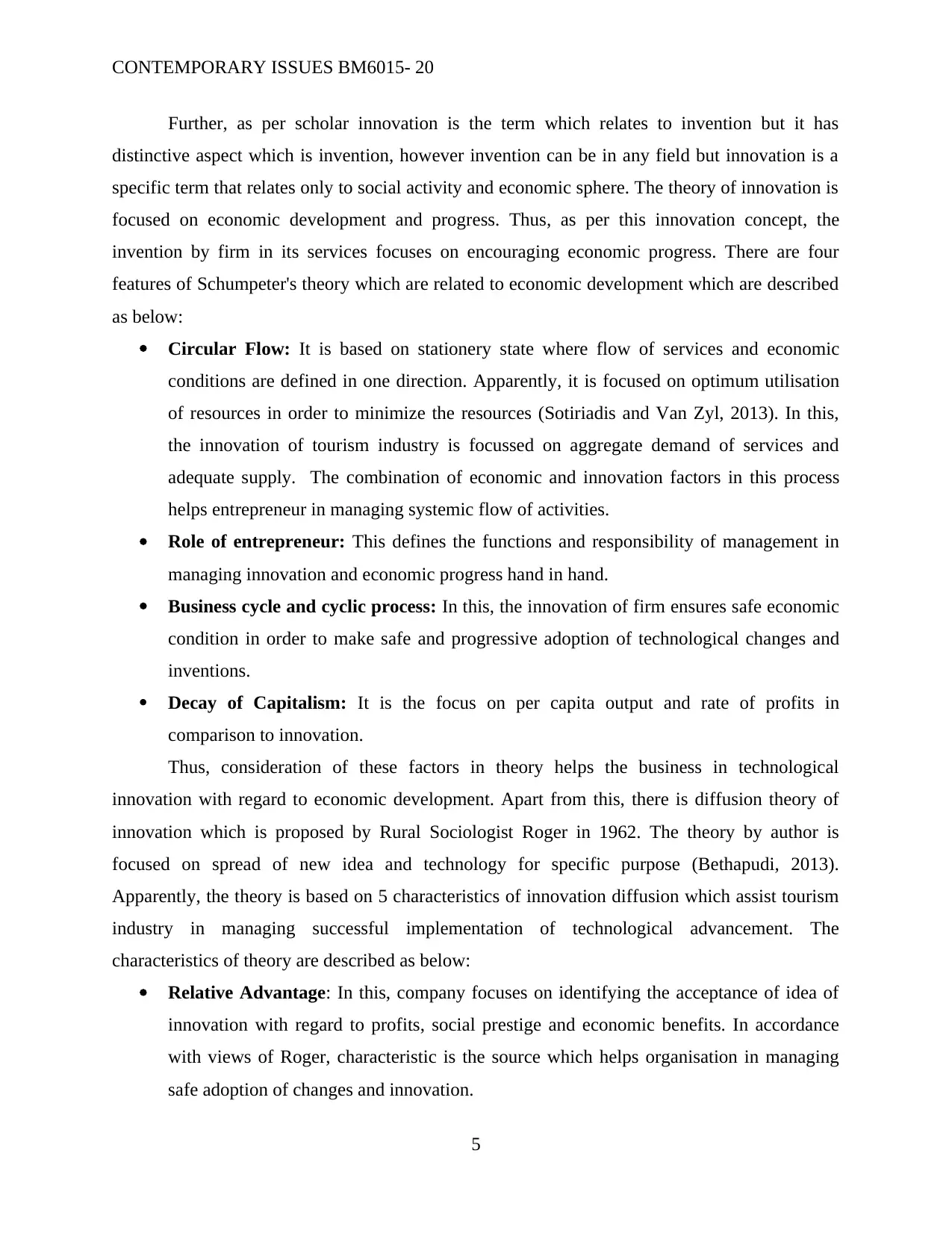
CONTEMPORARY ISSUES BM6015- 20
Further, as per scholar innovation is the term which relates to invention but it has
distinctive aspect which is invention, however invention can be in any field but innovation is a
specific term that relates only to social activity and economic sphere. The theory of innovation is
focused on economic development and progress. Thus, as per this innovation concept, the
invention by firm in its services focuses on encouraging economic progress. There are four
features of Schumpeter's theory which are related to economic development which are described
as below:
Circular Flow: It is based on stationery state where flow of services and economic
conditions are defined in one direction. Apparently, it is focused on optimum utilisation
of resources in order to minimize the resources (Sotiriadis and Van Zyl, 2013). In this,
the innovation of tourism industry is focussed on aggregate demand of services and
adequate supply. The combination of economic and innovation factors in this process
helps entrepreneur in managing systemic flow of activities.
Role of entrepreneur: This defines the functions and responsibility of management in
managing innovation and economic progress hand in hand.
Business cycle and cyclic process: In this, the innovation of firm ensures safe economic
condition in order to make safe and progressive adoption of technological changes and
inventions.
Decay of Capitalism: It is the focus on per capita output and rate of profits in
comparison to innovation.
Thus, consideration of these factors in theory helps the business in technological
innovation with regard to economic development. Apart from this, there is diffusion theory of
innovation which is proposed by Rural Sociologist Roger in 1962. The theory by author is
focused on spread of new idea and technology for specific purpose (Bethapudi, 2013).
Apparently, the theory is based on 5 characteristics of innovation diffusion which assist tourism
industry in managing successful implementation of technological advancement. The
characteristics of theory are described as below:
Relative Advantage: In this, company focuses on identifying the acceptance of idea of
innovation with regard to profits, social prestige and economic benefits. In accordance
with views of Roger, characteristic is the source which helps organisation in managing
safe adoption of changes and innovation.
5
Further, as per scholar innovation is the term which relates to invention but it has
distinctive aspect which is invention, however invention can be in any field but innovation is a
specific term that relates only to social activity and economic sphere. The theory of innovation is
focused on economic development and progress. Thus, as per this innovation concept, the
invention by firm in its services focuses on encouraging economic progress. There are four
features of Schumpeter's theory which are related to economic development which are described
as below:
Circular Flow: It is based on stationery state where flow of services and economic
conditions are defined in one direction. Apparently, it is focused on optimum utilisation
of resources in order to minimize the resources (Sotiriadis and Van Zyl, 2013). In this,
the innovation of tourism industry is focussed on aggregate demand of services and
adequate supply. The combination of economic and innovation factors in this process
helps entrepreneur in managing systemic flow of activities.
Role of entrepreneur: This defines the functions and responsibility of management in
managing innovation and economic progress hand in hand.
Business cycle and cyclic process: In this, the innovation of firm ensures safe economic
condition in order to make safe and progressive adoption of technological changes and
inventions.
Decay of Capitalism: It is the focus on per capita output and rate of profits in
comparison to innovation.
Thus, consideration of these factors in theory helps the business in technological
innovation with regard to economic development. Apart from this, there is diffusion theory of
innovation which is proposed by Rural Sociologist Roger in 1962. The theory by author is
focused on spread of new idea and technology for specific purpose (Bethapudi, 2013).
Apparently, the theory is based on 5 characteristics of innovation diffusion which assist tourism
industry in managing successful implementation of technological advancement. The
characteristics of theory are described as below:
Relative Advantage: In this, company focuses on identifying the acceptance of idea of
innovation with regard to profits, social prestige and economic benefits. In accordance
with views of Roger, characteristic is the source which helps organisation in managing
safe adoption of changes and innovation.
5
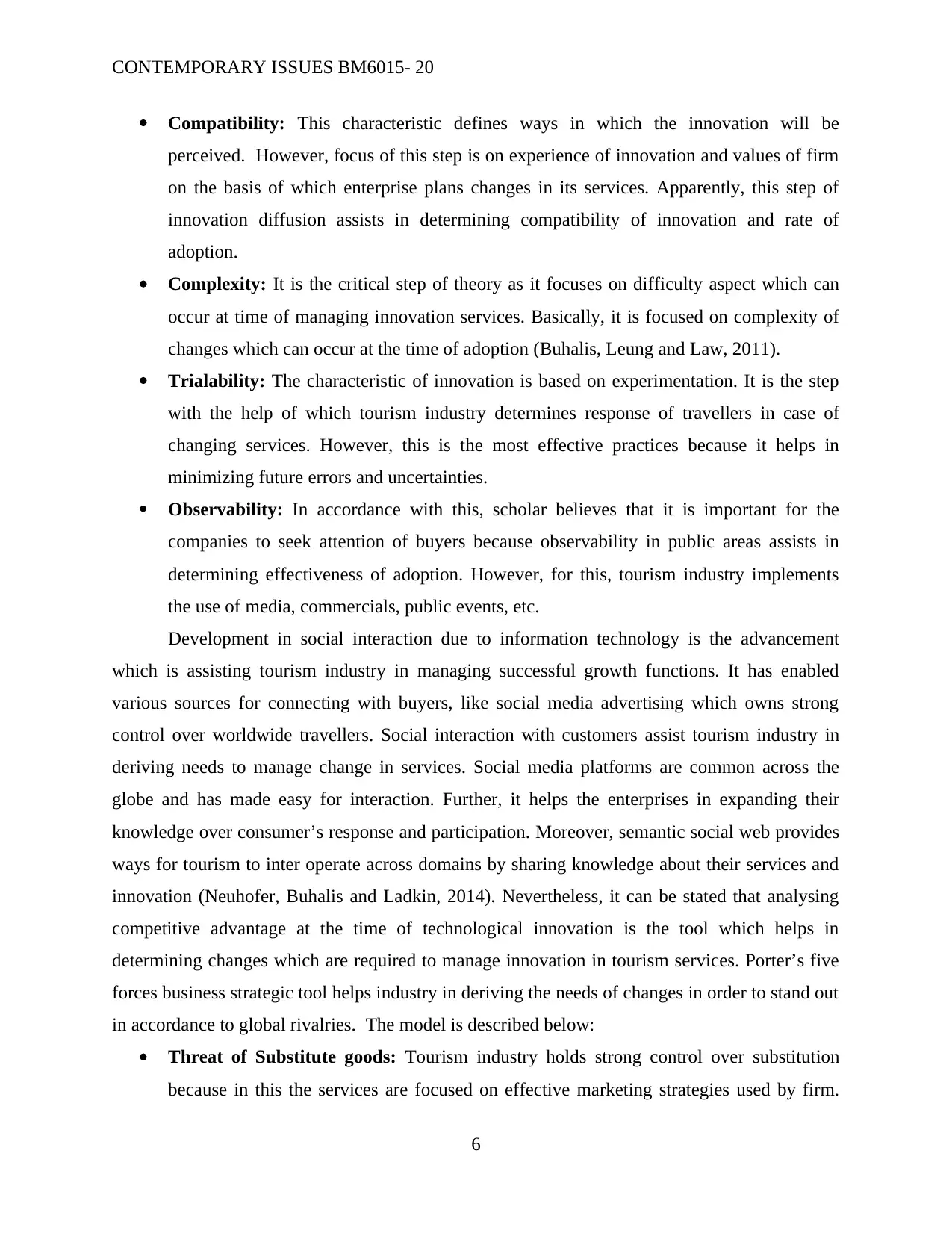
CONTEMPORARY ISSUES BM6015- 20
Compatibility: This characteristic defines ways in which the innovation will be
perceived. However, focus of this step is on experience of innovation and values of firm
on the basis of which enterprise plans changes in its services. Apparently, this step of
innovation diffusion assists in determining compatibility of innovation and rate of
adoption.
Complexity: It is the critical step of theory as it focuses on difficulty aspect which can
occur at time of managing innovation services. Basically, it is focused on complexity of
changes which can occur at the time of adoption (Buhalis, Leung and Law, 2011).
Trialability: The characteristic of innovation is based on experimentation. It is the step
with the help of which tourism industry determines response of travellers in case of
changing services. However, this is the most effective practices because it helps in
minimizing future errors and uncertainties.
Observability: In accordance with this, scholar believes that it is important for the
companies to seek attention of buyers because observability in public areas assists in
determining effectiveness of adoption. However, for this, tourism industry implements
the use of media, commercials, public events, etc.
Development in social interaction due to information technology is the advancement
which is assisting tourism industry in managing successful growth functions. It has enabled
various sources for connecting with buyers, like social media advertising which owns strong
control over worldwide travellers. Social interaction with customers assist tourism industry in
deriving needs to manage change in services. Social media platforms are common across the
globe and has made easy for interaction. Further, it helps the enterprises in expanding their
knowledge over consumer’s response and participation. Moreover, semantic social web provides
ways for tourism to inter operate across domains by sharing knowledge about their services and
innovation (Neuhofer, Buhalis and Ladkin, 2014). Nevertheless, it can be stated that analysing
competitive advantage at the time of technological innovation is the tool which helps in
determining changes which are required to manage innovation in tourism services. Porter’s five
forces business strategic tool helps industry in deriving the needs of changes in order to stand out
in accordance to global rivalries. The model is described below:
Threat of Substitute goods: Tourism industry holds strong control over substitution
because in this the services are focused on effective marketing strategies used by firm.
6
Compatibility: This characteristic defines ways in which the innovation will be
perceived. However, focus of this step is on experience of innovation and values of firm
on the basis of which enterprise plans changes in its services. Apparently, this step of
innovation diffusion assists in determining compatibility of innovation and rate of
adoption.
Complexity: It is the critical step of theory as it focuses on difficulty aspect which can
occur at time of managing innovation services. Basically, it is focused on complexity of
changes which can occur at the time of adoption (Buhalis, Leung and Law, 2011).
Trialability: The characteristic of innovation is based on experimentation. It is the step
with the help of which tourism industry determines response of travellers in case of
changing services. However, this is the most effective practices because it helps in
minimizing future errors and uncertainties.
Observability: In accordance with this, scholar believes that it is important for the
companies to seek attention of buyers because observability in public areas assists in
determining effectiveness of adoption. However, for this, tourism industry implements
the use of media, commercials, public events, etc.
Development in social interaction due to information technology is the advancement
which is assisting tourism industry in managing successful growth functions. It has enabled
various sources for connecting with buyers, like social media advertising which owns strong
control over worldwide travellers. Social interaction with customers assist tourism industry in
deriving needs to manage change in services. Social media platforms are common across the
globe and has made easy for interaction. Further, it helps the enterprises in expanding their
knowledge over consumer’s response and participation. Moreover, semantic social web provides
ways for tourism to inter operate across domains by sharing knowledge about their services and
innovation (Neuhofer, Buhalis and Ladkin, 2014). Nevertheless, it can be stated that analysing
competitive advantage at the time of technological innovation is the tool which helps in
determining changes which are required to manage innovation in tourism services. Porter’s five
forces business strategic tool helps industry in deriving the needs of changes in order to stand out
in accordance to global rivalries. The model is described below:
Threat of Substitute goods: Tourism industry holds strong control over substitution
because in this the services are focused on effective marketing strategies used by firm.
6
⊘ This is a preview!⊘
Do you want full access?
Subscribe today to unlock all pages.

Trusted by 1+ million students worldwide
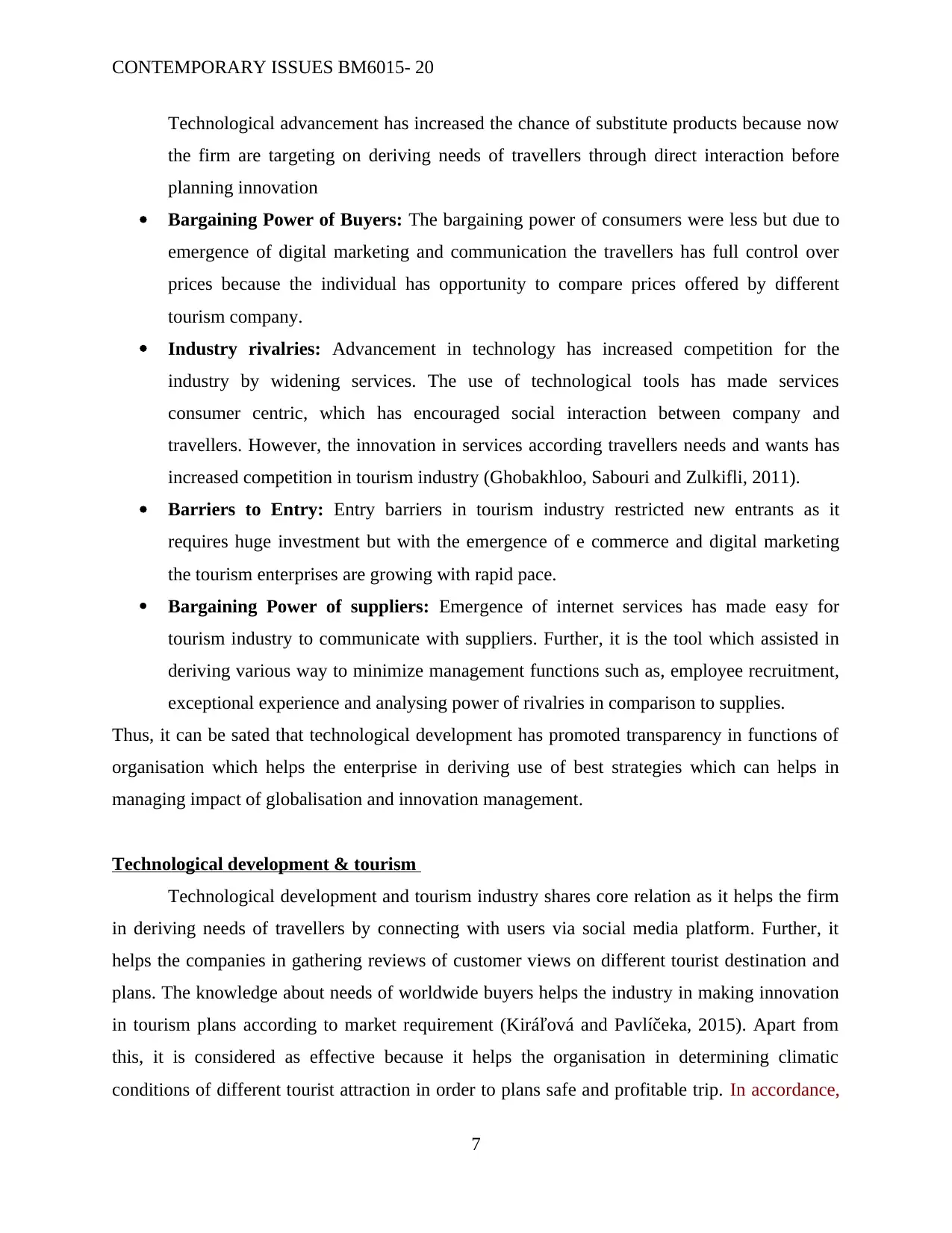
CONTEMPORARY ISSUES BM6015- 20
Technological advancement has increased the chance of substitute products because now
the firm are targeting on deriving needs of travellers through direct interaction before
planning innovation
Bargaining Power of Buyers: The bargaining power of consumers were less but due to
emergence of digital marketing and communication the travellers has full control over
prices because the individual has opportunity to compare prices offered by different
tourism company.
Industry rivalries: Advancement in technology has increased competition for the
industry by widening services. The use of technological tools has made services
consumer centric, which has encouraged social interaction between company and
travellers. However, the innovation in services according travellers needs and wants has
increased competition in tourism industry (Ghobakhloo, Sabouri and Zulkifli, 2011).
Barriers to Entry: Entry barriers in tourism industry restricted new entrants as it
requires huge investment but with the emergence of e commerce and digital marketing
the tourism enterprises are growing with rapid pace.
Bargaining Power of suppliers: Emergence of internet services has made easy for
tourism industry to communicate with suppliers. Further, it is the tool which assisted in
deriving various way to minimize management functions such as, employee recruitment,
exceptional experience and analysing power of rivalries in comparison to supplies.
Thus, it can be sated that technological development has promoted transparency in functions of
organisation which helps the enterprise in deriving use of best strategies which can helps in
managing impact of globalisation and innovation management.
Technological development & tourism
Technological development and tourism industry shares core relation as it helps the firm
in deriving needs of travellers by connecting with users via social media platform. Further, it
helps the companies in gathering reviews of customer views on different tourist destination and
plans. The knowledge about needs of worldwide buyers helps the industry in making innovation
in tourism plans according to market requirement (Kiráľová and Pavlíčeka, 2015). Apart from
this, it is considered as effective because it helps the organisation in determining climatic
conditions of different tourist attraction in order to plans safe and profitable trip. In accordance,
7
Technological advancement has increased the chance of substitute products because now
the firm are targeting on deriving needs of travellers through direct interaction before
planning innovation
Bargaining Power of Buyers: The bargaining power of consumers were less but due to
emergence of digital marketing and communication the travellers has full control over
prices because the individual has opportunity to compare prices offered by different
tourism company.
Industry rivalries: Advancement in technology has increased competition for the
industry by widening services. The use of technological tools has made services
consumer centric, which has encouraged social interaction between company and
travellers. However, the innovation in services according travellers needs and wants has
increased competition in tourism industry (Ghobakhloo, Sabouri and Zulkifli, 2011).
Barriers to Entry: Entry barriers in tourism industry restricted new entrants as it
requires huge investment but with the emergence of e commerce and digital marketing
the tourism enterprises are growing with rapid pace.
Bargaining Power of suppliers: Emergence of internet services has made easy for
tourism industry to communicate with suppliers. Further, it is the tool which assisted in
deriving various way to minimize management functions such as, employee recruitment,
exceptional experience and analysing power of rivalries in comparison to supplies.
Thus, it can be sated that technological development has promoted transparency in functions of
organisation which helps the enterprise in deriving use of best strategies which can helps in
managing impact of globalisation and innovation management.
Technological development & tourism
Technological development and tourism industry shares core relation as it helps the firm
in deriving needs of travellers by connecting with users via social media platform. Further, it
helps the companies in gathering reviews of customer views on different tourist destination and
plans. The knowledge about needs of worldwide buyers helps the industry in making innovation
in tourism plans according to market requirement (Kiráľová and Pavlíčeka, 2015). Apart from
this, it is considered as effective because it helps the organisation in determining climatic
conditions of different tourist attraction in order to plans safe and profitable trip. In accordance,
7
Paraphrase This Document
Need a fresh take? Get an instant paraphrase of this document with our AI Paraphraser
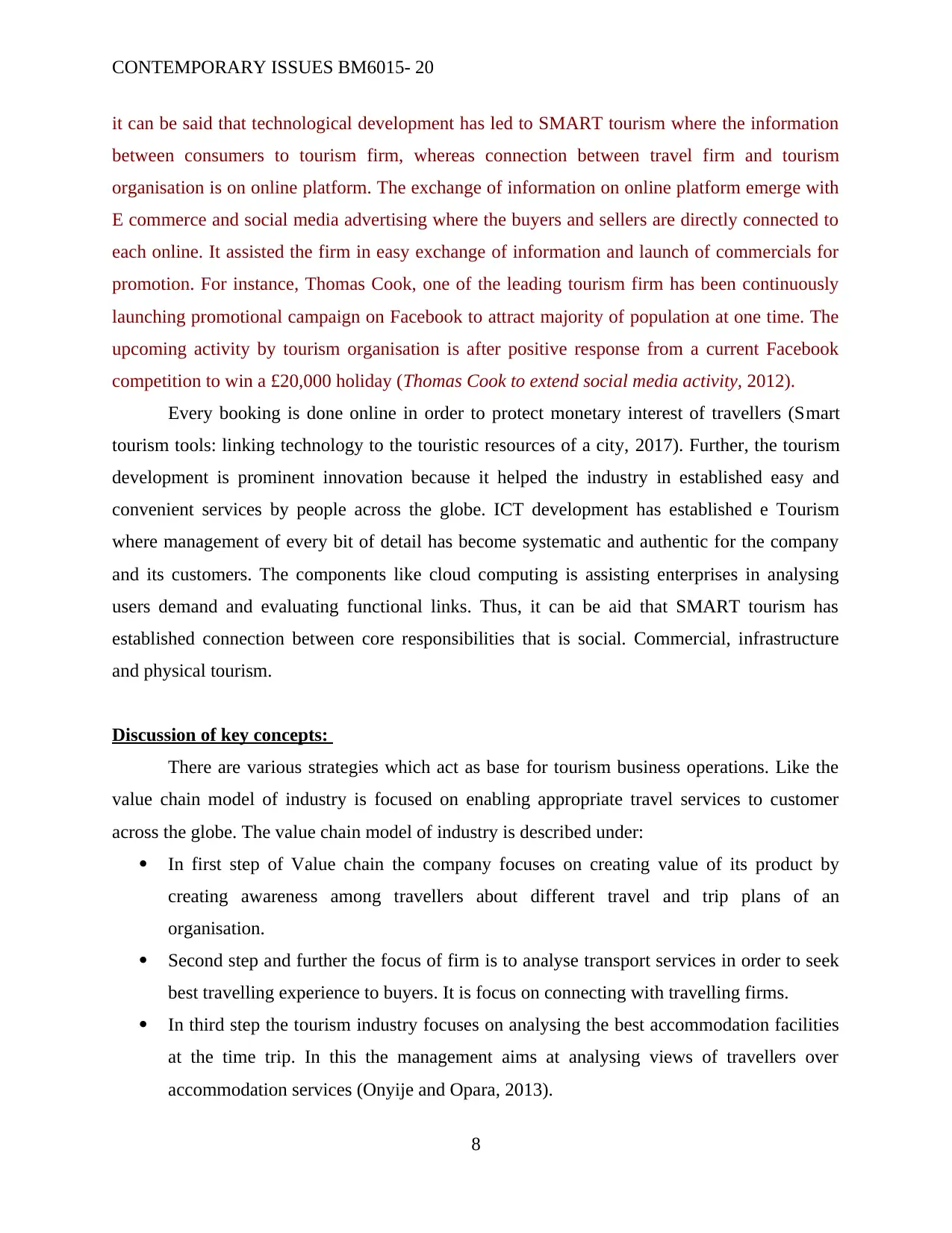
CONTEMPORARY ISSUES BM6015- 20
it can be said that technological development has led to SMART tourism where the information
between consumers to tourism firm, whereas connection between travel firm and tourism
organisation is on online platform. The exchange of information on online platform emerge with
E commerce and social media advertising where the buyers and sellers are directly connected to
each online. It assisted the firm in easy exchange of information and launch of commercials for
promotion. For instance, Thomas Cook, one of the leading tourism firm has been continuously
launching promotional campaign on Facebook to attract majority of population at one time. The
upcoming activity by tourism organisation is after positive response from a current Facebook
competition to win a £20,000 holiday (Thomas Cook to extend social media activity, 2012).
Every booking is done online in order to protect monetary interest of travellers (Smart
tourism tools: linking technology to the touristic resources of a city, 2017). Further, the tourism
development is prominent innovation because it helped the industry in established easy and
convenient services by people across the globe. ICT development has established e Tourism
where management of every bit of detail has become systematic and authentic for the company
and its customers. The components like cloud computing is assisting enterprises in analysing
users demand and evaluating functional links. Thus, it can be aid that SMART tourism has
established connection between core responsibilities that is social. Commercial, infrastructure
and physical tourism.
Discussion of key concepts:
There are various strategies which act as base for tourism business operations. Like the
value chain model of industry is focused on enabling appropriate travel services to customer
across the globe. The value chain model of industry is described under:
In first step of Value chain the company focuses on creating value of its product by
creating awareness among travellers about different travel and trip plans of an
organisation.
Second step and further the focus of firm is to analyse transport services in order to seek
best travelling experience to buyers. It is focus on connecting with travelling firms.
In third step the tourism industry focuses on analysing the best accommodation facilities
at the time trip. In this the management aims at analysing views of travellers over
accommodation services (Onyije and Opara, 2013).
8
it can be said that technological development has led to SMART tourism where the information
between consumers to tourism firm, whereas connection between travel firm and tourism
organisation is on online platform. The exchange of information on online platform emerge with
E commerce and social media advertising where the buyers and sellers are directly connected to
each online. It assisted the firm in easy exchange of information and launch of commercials for
promotion. For instance, Thomas Cook, one of the leading tourism firm has been continuously
launching promotional campaign on Facebook to attract majority of population at one time. The
upcoming activity by tourism organisation is after positive response from a current Facebook
competition to win a £20,000 holiday (Thomas Cook to extend social media activity, 2012).
Every booking is done online in order to protect monetary interest of travellers (Smart
tourism tools: linking technology to the touristic resources of a city, 2017). Further, the tourism
development is prominent innovation because it helped the industry in established easy and
convenient services by people across the globe. ICT development has established e Tourism
where management of every bit of detail has become systematic and authentic for the company
and its customers. The components like cloud computing is assisting enterprises in analysing
users demand and evaluating functional links. Thus, it can be aid that SMART tourism has
established connection between core responsibilities that is social. Commercial, infrastructure
and physical tourism.
Discussion of key concepts:
There are various strategies which act as base for tourism business operations. Like the
value chain model of industry is focused on enabling appropriate travel services to customer
across the globe. The value chain model of industry is described under:
In first step of Value chain the company focuses on creating value of its product by
creating awareness among travellers about different travel and trip plans of an
organisation.
Second step and further the focus of firm is to analyse transport services in order to seek
best travelling experience to buyers. It is focus on connecting with travelling firms.
In third step the tourism industry focuses on analysing the best accommodation facilities
at the time trip. In this the management aims at analysing views of travellers over
accommodation services (Onyije and Opara, 2013).
8
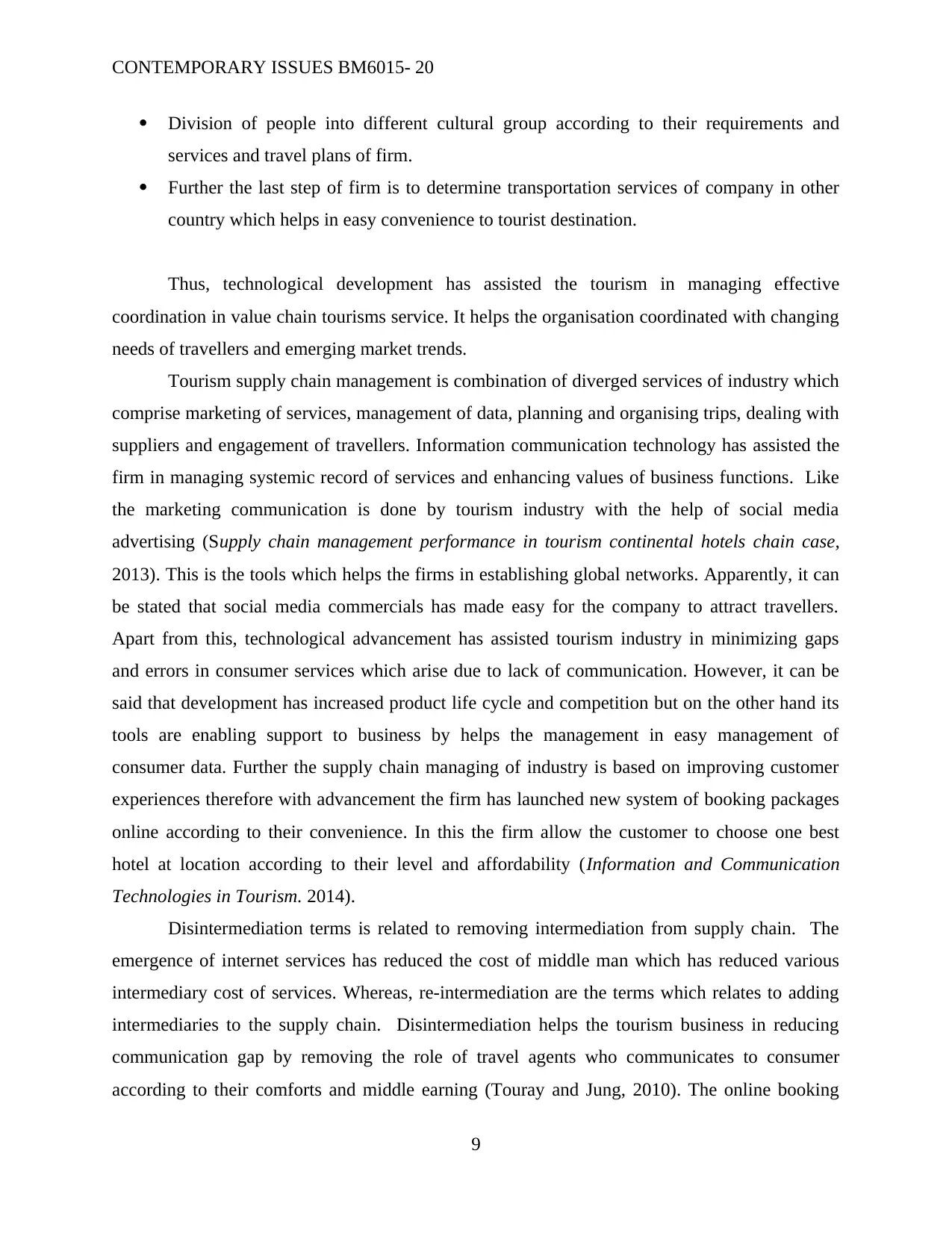
CONTEMPORARY ISSUES BM6015- 20
Division of people into different cultural group according to their requirements and
services and travel plans of firm.
Further the last step of firm is to determine transportation services of company in other
country which helps in easy convenience to tourist destination.
Thus, technological development has assisted the tourism in managing effective
coordination in value chain tourisms service. It helps the organisation coordinated with changing
needs of travellers and emerging market trends.
Tourism supply chain management is combination of diverged services of industry which
comprise marketing of services, management of data, planning and organising trips, dealing with
suppliers and engagement of travellers. Information communication technology has assisted the
firm in managing systemic record of services and enhancing values of business functions. Like
the marketing communication is done by tourism industry with the help of social media
advertising (Supply chain management performance in tourism continental hotels chain case,
2013). This is the tools which helps the firms in establishing global networks. Apparently, it can
be stated that social media commercials has made easy for the company to attract travellers.
Apart from this, technological advancement has assisted tourism industry in minimizing gaps
and errors in consumer services which arise due to lack of communication. However, it can be
said that development has increased product life cycle and competition but on the other hand its
tools are enabling support to business by helps the management in easy management of
consumer data. Further the supply chain managing of industry is based on improving customer
experiences therefore with advancement the firm has launched new system of booking packages
online according to their convenience. In this the firm allow the customer to choose one best
hotel at location according to their level and affordability (Information and Communication
Technologies in Tourism. 2014).
Disintermediation terms is related to removing intermediation from supply chain. The
emergence of internet services has reduced the cost of middle man which has reduced various
intermediary cost of services. Whereas, re-intermediation are the terms which relates to adding
intermediaries to the supply chain. Disintermediation helps the tourism business in reducing
communication gap by removing the role of travel agents who communicates to consumer
according to their comforts and middle earning (Touray and Jung, 2010). The online booking
9
Division of people into different cultural group according to their requirements and
services and travel plans of firm.
Further the last step of firm is to determine transportation services of company in other
country which helps in easy convenience to tourist destination.
Thus, technological development has assisted the tourism in managing effective
coordination in value chain tourisms service. It helps the organisation coordinated with changing
needs of travellers and emerging market trends.
Tourism supply chain management is combination of diverged services of industry which
comprise marketing of services, management of data, planning and organising trips, dealing with
suppliers and engagement of travellers. Information communication technology has assisted the
firm in managing systemic record of services and enhancing values of business functions. Like
the marketing communication is done by tourism industry with the help of social media
advertising (Supply chain management performance in tourism continental hotels chain case,
2013). This is the tools which helps the firms in establishing global networks. Apparently, it can
be stated that social media commercials has made easy for the company to attract travellers.
Apart from this, technological advancement has assisted tourism industry in minimizing gaps
and errors in consumer services which arise due to lack of communication. However, it can be
said that development has increased product life cycle and competition but on the other hand its
tools are enabling support to business by helps the management in easy management of
consumer data. Further the supply chain managing of industry is based on improving customer
experiences therefore with advancement the firm has launched new system of booking packages
online according to their convenience. In this the firm allow the customer to choose one best
hotel at location according to their level and affordability (Information and Communication
Technologies in Tourism. 2014).
Disintermediation terms is related to removing intermediation from supply chain. The
emergence of internet services has reduced the cost of middle man which has reduced various
intermediary cost of services. Whereas, re-intermediation are the terms which relates to adding
intermediaries to the supply chain. Disintermediation helps the tourism business in reducing
communication gap by removing the role of travel agents who communicates to consumer
according to their comforts and middle earning (Touray and Jung, 2010). The online booking
9
⊘ This is a preview!⊘
Do you want full access?
Subscribe today to unlock all pages.

Trusted by 1+ million students worldwide
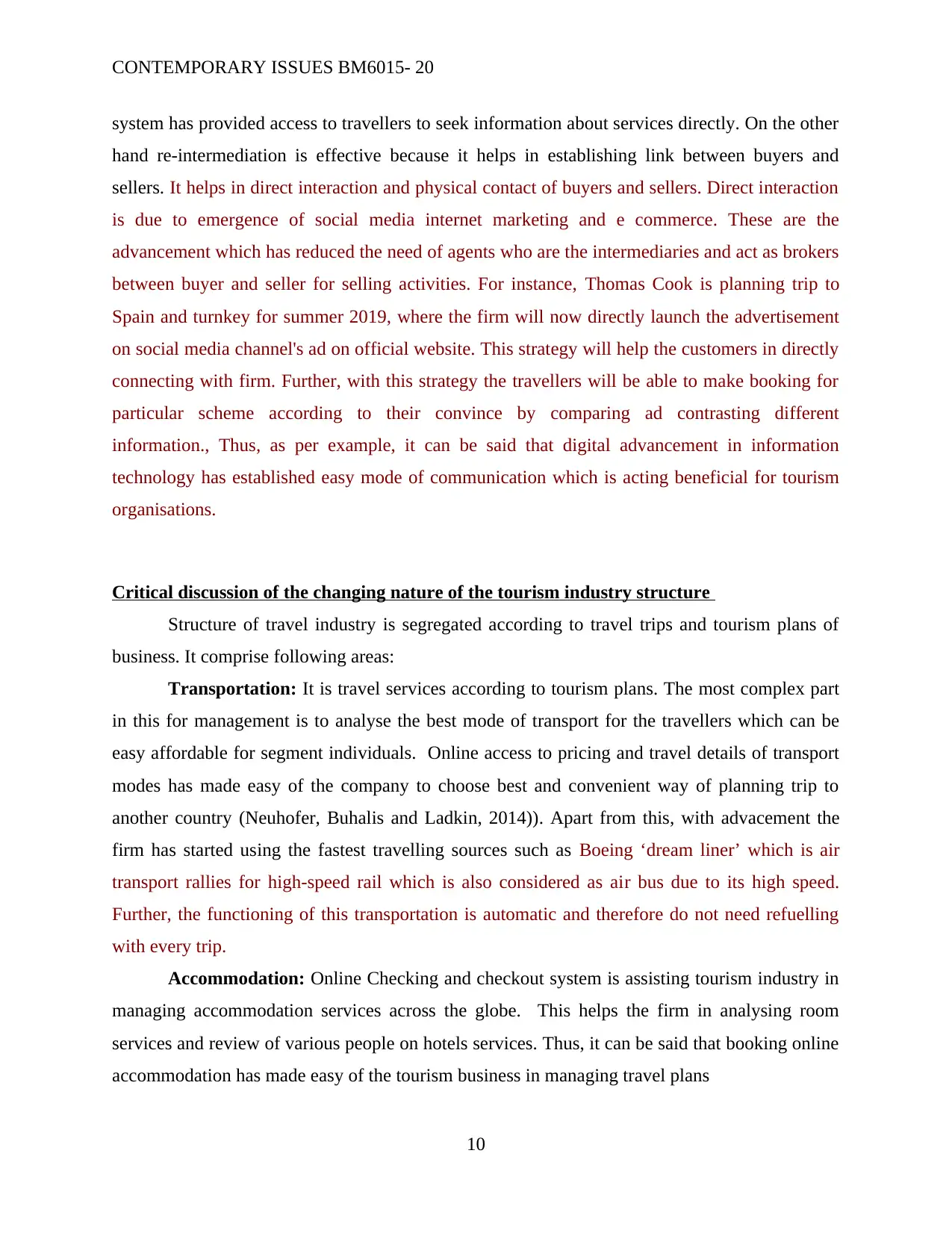
CONTEMPORARY ISSUES BM6015- 20
system has provided access to travellers to seek information about services directly. On the other
hand re-intermediation is effective because it helps in establishing link between buyers and
sellers. It helps in direct interaction and physical contact of buyers and sellers. Direct interaction
is due to emergence of social media internet marketing and e commerce. These are the
advancement which has reduced the need of agents who are the intermediaries and act as brokers
between buyer and seller for selling activities. For instance, Thomas Cook is planning trip to
Spain and turnkey for summer 2019, where the firm will now directly launch the advertisement
on social media channel's ad on official website. This strategy will help the customers in directly
connecting with firm. Further, with this strategy the travellers will be able to make booking for
particular scheme according to their convince by comparing ad contrasting different
information., Thus, as per example, it can be said that digital advancement in information
technology has established easy mode of communication which is acting beneficial for tourism
organisations.
Critical discussion of the changing nature of the tourism industry structure
Structure of travel industry is segregated according to travel trips and tourism plans of
business. It comprise following areas:
Transportation: It is travel services according to tourism plans. The most complex part
in this for management is to analyse the best mode of transport for the travellers which can be
easy affordable for segment individuals. Online access to pricing and travel details of transport
modes has made easy of the company to choose best and convenient way of planning trip to
another country (Neuhofer, Buhalis and Ladkin, 2014)). Apart from this, with advacement the
firm has started using the fastest travelling sources such as Boeing ‘dream liner’ which is air
transport rallies for high-speed rail which is also considered as air bus due to its high speed.
Further, the functioning of this transportation is automatic and therefore do not need refuelling
with every trip.
Accommodation: Online Checking and checkout system is assisting tourism industry in
managing accommodation services across the globe. This helps the firm in analysing room
services and review of various people on hotels services. Thus, it can be said that booking online
accommodation has made easy of the tourism business in managing travel plans
10
system has provided access to travellers to seek information about services directly. On the other
hand re-intermediation is effective because it helps in establishing link between buyers and
sellers. It helps in direct interaction and physical contact of buyers and sellers. Direct interaction
is due to emergence of social media internet marketing and e commerce. These are the
advancement which has reduced the need of agents who are the intermediaries and act as brokers
between buyer and seller for selling activities. For instance, Thomas Cook is planning trip to
Spain and turnkey for summer 2019, where the firm will now directly launch the advertisement
on social media channel's ad on official website. This strategy will help the customers in directly
connecting with firm. Further, with this strategy the travellers will be able to make booking for
particular scheme according to their convince by comparing ad contrasting different
information., Thus, as per example, it can be said that digital advancement in information
technology has established easy mode of communication which is acting beneficial for tourism
organisations.
Critical discussion of the changing nature of the tourism industry structure
Structure of travel industry is segregated according to travel trips and tourism plans of
business. It comprise following areas:
Transportation: It is travel services according to tourism plans. The most complex part
in this for management is to analyse the best mode of transport for the travellers which can be
easy affordable for segment individuals. Online access to pricing and travel details of transport
modes has made easy of the company to choose best and convenient way of planning trip to
another country (Neuhofer, Buhalis and Ladkin, 2014)). Apart from this, with advacement the
firm has started using the fastest travelling sources such as Boeing ‘dream liner’ which is air
transport rallies for high-speed rail which is also considered as air bus due to its high speed.
Further, the functioning of this transportation is automatic and therefore do not need refuelling
with every trip.
Accommodation: Online Checking and checkout system is assisting tourism industry in
managing accommodation services across the globe. This helps the firm in analysing room
services and review of various people on hotels services. Thus, it can be said that booking online
accommodation has made easy of the tourism business in managing travel plans
10
Paraphrase This Document
Need a fresh take? Get an instant paraphrase of this document with our AI Paraphraser
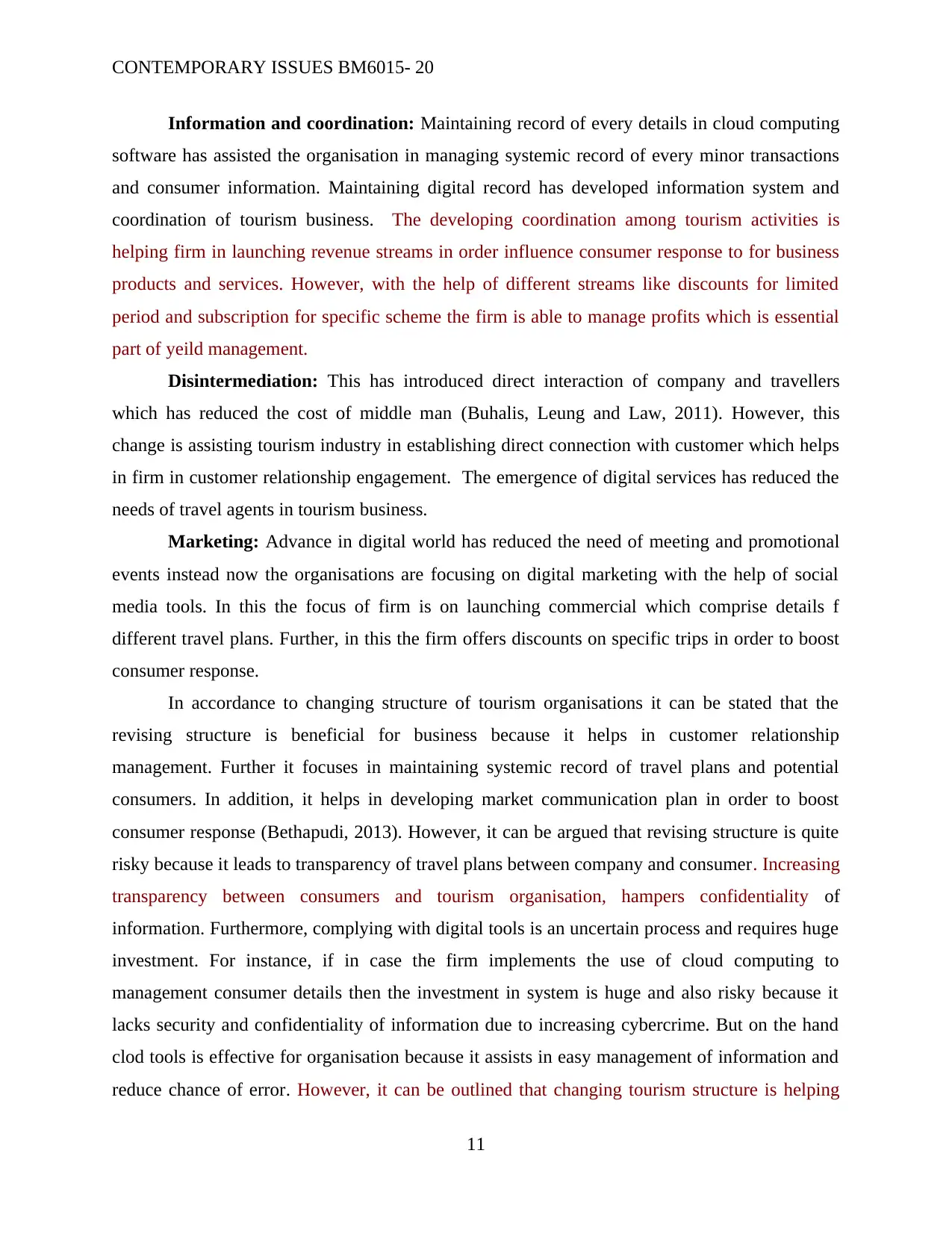
CONTEMPORARY ISSUES BM6015- 20
Information and coordination: Maintaining record of every details in cloud computing
software has assisted the organisation in managing systemic record of every minor transactions
and consumer information. Maintaining digital record has developed information system and
coordination of tourism business. The developing coordination among tourism activities is
helping firm in launching revenue streams in order influence consumer response to for business
products and services. However, with the help of different streams like discounts for limited
period and subscription for specific scheme the firm is able to manage profits which is essential
part of yeild management.
Disintermediation: This has introduced direct interaction of company and travellers
which has reduced the cost of middle man (Buhalis, Leung and Law, 2011). However, this
change is assisting tourism industry in establishing direct connection with customer which helps
in firm in customer relationship engagement. The emergence of digital services has reduced the
needs of travel agents in tourism business.
Marketing: Advance in digital world has reduced the need of meeting and promotional
events instead now the organisations are focusing on digital marketing with the help of social
media tools. In this the focus of firm is on launching commercial which comprise details f
different travel plans. Further, in this the firm offers discounts on specific trips in order to boost
consumer response.
In accordance to changing structure of tourism organisations it can be stated that the
revising structure is beneficial for business because it helps in customer relationship
management. Further it focuses in maintaining systemic record of travel plans and potential
consumers. In addition, it helps in developing market communication plan in order to boost
consumer response (Bethapudi, 2013). However, it can be argued that revising structure is quite
risky because it leads to transparency of travel plans between company and consumer. Increasing
transparency between consumers and tourism organisation, hampers confidentiality of
information. Furthermore, complying with digital tools is an uncertain process and requires huge
investment. For instance, if in case the firm implements the use of cloud computing to
management consumer details then the investment in system is huge and also risky because it
lacks security and confidentiality of information due to increasing cybercrime. But on the hand
clod tools is effective for organisation because it assists in easy management of information and
reduce chance of error. However, it can be outlined that changing tourism structure is helping
11
Information and coordination: Maintaining record of every details in cloud computing
software has assisted the organisation in managing systemic record of every minor transactions
and consumer information. Maintaining digital record has developed information system and
coordination of tourism business. The developing coordination among tourism activities is
helping firm in launching revenue streams in order influence consumer response to for business
products and services. However, with the help of different streams like discounts for limited
period and subscription for specific scheme the firm is able to manage profits which is essential
part of yeild management.
Disintermediation: This has introduced direct interaction of company and travellers
which has reduced the cost of middle man (Buhalis, Leung and Law, 2011). However, this
change is assisting tourism industry in establishing direct connection with customer which helps
in firm in customer relationship engagement. The emergence of digital services has reduced the
needs of travel agents in tourism business.
Marketing: Advance in digital world has reduced the need of meeting and promotional
events instead now the organisations are focusing on digital marketing with the help of social
media tools. In this the focus of firm is on launching commercial which comprise details f
different travel plans. Further, in this the firm offers discounts on specific trips in order to boost
consumer response.
In accordance to changing structure of tourism organisations it can be stated that the
revising structure is beneficial for business because it helps in customer relationship
management. Further it focuses in maintaining systemic record of travel plans and potential
consumers. In addition, it helps in developing market communication plan in order to boost
consumer response (Bethapudi, 2013). However, it can be argued that revising structure is quite
risky because it leads to transparency of travel plans between company and consumer. Increasing
transparency between consumers and tourism organisation, hampers confidentiality of
information. Furthermore, complying with digital tools is an uncertain process and requires huge
investment. For instance, if in case the firm implements the use of cloud computing to
management consumer details then the investment in system is huge and also risky because it
lacks security and confidentiality of information due to increasing cybercrime. But on the hand
clod tools is effective for organisation because it assists in easy management of information and
reduce chance of error. However, it can be outlined that changing tourism structure is helping
11
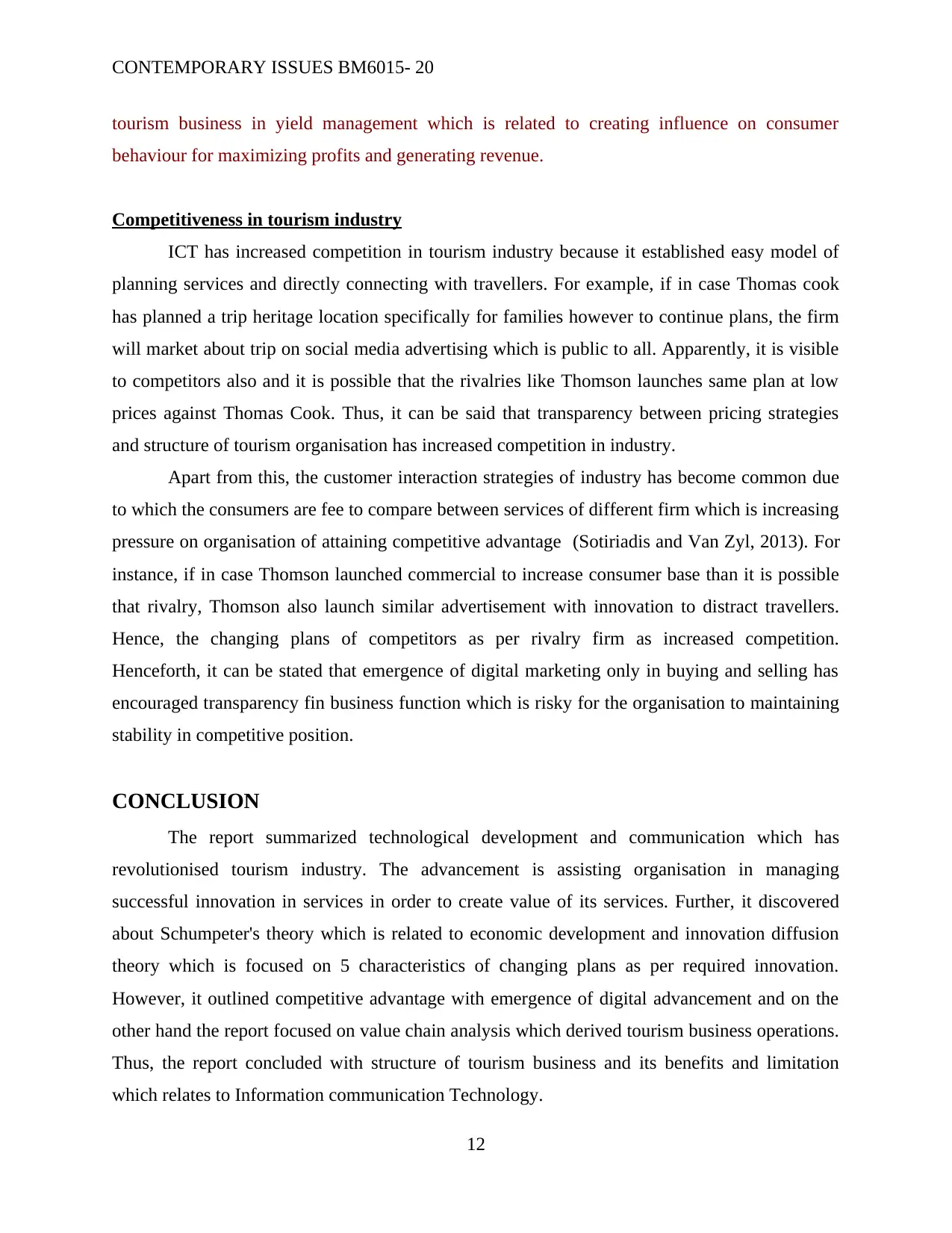
CONTEMPORARY ISSUES BM6015- 20
tourism business in yield management which is related to creating influence on consumer
behaviour for maximizing profits and generating revenue.
Competitiveness in tourism industry
ICT has increased competition in tourism industry because it established easy model of
planning services and directly connecting with travellers. For example, if in case Thomas cook
has planned a trip heritage location specifically for families however to continue plans, the firm
will market about trip on social media advertising which is public to all. Apparently, it is visible
to competitors also and it is possible that the rivalries like Thomson launches same plan at low
prices against Thomas Cook. Thus, it can be said that transparency between pricing strategies
and structure of tourism organisation has increased competition in industry.
Apart from this, the customer interaction strategies of industry has become common due
to which the consumers are fee to compare between services of different firm which is increasing
pressure on organisation of attaining competitive advantage (Sotiriadis and Van Zyl, 2013). For
instance, if in case Thomson launched commercial to increase consumer base than it is possible
that rivalry, Thomson also launch similar advertisement with innovation to distract travellers.
Hence, the changing plans of competitors as per rivalry firm as increased competition.
Henceforth, it can be stated that emergence of digital marketing only in buying and selling has
encouraged transparency fin business function which is risky for the organisation to maintaining
stability in competitive position.
CONCLUSION
The report summarized technological development and communication which has
revolutionised tourism industry. The advancement is assisting organisation in managing
successful innovation in services in order to create value of its services. Further, it discovered
about Schumpeter's theory which is related to economic development and innovation diffusion
theory which is focused on 5 characteristics of changing plans as per required innovation.
However, it outlined competitive advantage with emergence of digital advancement and on the
other hand the report focused on value chain analysis which derived tourism business operations.
Thus, the report concluded with structure of tourism business and its benefits and limitation
which relates to Information communication Technology.
12
tourism business in yield management which is related to creating influence on consumer
behaviour for maximizing profits and generating revenue.
Competitiveness in tourism industry
ICT has increased competition in tourism industry because it established easy model of
planning services and directly connecting with travellers. For example, if in case Thomas cook
has planned a trip heritage location specifically for families however to continue plans, the firm
will market about trip on social media advertising which is public to all. Apparently, it is visible
to competitors also and it is possible that the rivalries like Thomson launches same plan at low
prices against Thomas Cook. Thus, it can be said that transparency between pricing strategies
and structure of tourism organisation has increased competition in industry.
Apart from this, the customer interaction strategies of industry has become common due
to which the consumers are fee to compare between services of different firm which is increasing
pressure on organisation of attaining competitive advantage (Sotiriadis and Van Zyl, 2013). For
instance, if in case Thomson launched commercial to increase consumer base than it is possible
that rivalry, Thomson also launch similar advertisement with innovation to distract travellers.
Hence, the changing plans of competitors as per rivalry firm as increased competition.
Henceforth, it can be stated that emergence of digital marketing only in buying and selling has
encouraged transparency fin business function which is risky for the organisation to maintaining
stability in competitive position.
CONCLUSION
The report summarized technological development and communication which has
revolutionised tourism industry. The advancement is assisting organisation in managing
successful innovation in services in order to create value of its services. Further, it discovered
about Schumpeter's theory which is related to economic development and innovation diffusion
theory which is focused on 5 characteristics of changing plans as per required innovation.
However, it outlined competitive advantage with emergence of digital advancement and on the
other hand the report focused on value chain analysis which derived tourism business operations.
Thus, the report concluded with structure of tourism business and its benefits and limitation
which relates to Information communication Technology.
12
⊘ This is a preview!⊘
Do you want full access?
Subscribe today to unlock all pages.

Trusted by 1+ million students worldwide
1 out of 15
Related Documents
Your All-in-One AI-Powered Toolkit for Academic Success.
+13062052269
info@desklib.com
Available 24*7 on WhatsApp / Email
![[object Object]](/_next/static/media/star-bottom.7253800d.svg)
Unlock your academic potential
Copyright © 2020–2025 A2Z Services. All Rights Reserved. Developed and managed by ZUCOL.





